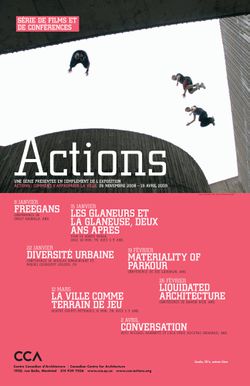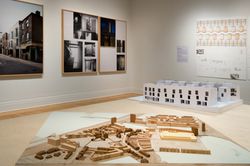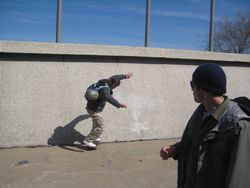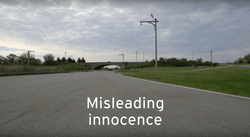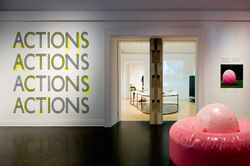Sub-series
AP075.S3.SS2
Description:
This sub-series documents Cornelia Hahn Oberlander's administrative records of her practice as landscape architect from the end of the 1950s to the end ot the 2010s. It comprises material related to her consulting services on her own various landscape projects and urban planning projects, and also her consulting services for projects submitted as member of a larger project team for private or public projects. Her office records also contains documents related the planning of her work, her patents applications and designs for her own landscape or playground furnitures, and her professional correspondence. The sub-series also documents Oberlander press and promotional activities, such as interviews she gave, articles written about her, about her work as landscape architect, her statements or her activism for social and environmental causes or preservation landmark buildings and spaces. The sub-series contains documents related to Oberlander's consulting services, including requests for services, proposals by her or by the project team, correspondence, or documentation collected for projects calls of interest to Oberlander. Oberlander's office records for planning of projects and other activities includes professional correspondence files, agendas and planners, message books and notebooks, patents applications and plans for her designs, and office references, such landscape architecture regulations and guidelines, and landscape specifications templates. The sub-series also comprises promotional material, such as photographs of her previous projects, press clippings of articles or periodicals with articles about her or her work, promotional panels for some of her major projects, and brochures or leaflets on her most well known projects. It includes also contains recordings of interviews on TV or radio shows she gave, biographical information on Oberlander, versions of her CV's, portaits of her, and lists and project write-ups.
1953-2018
Administrative records and promotional material
Actions:
AP075.S3.SS2
Description:
This sub-series documents Cornelia Hahn Oberlander's administrative records of her practice as landscape architect from the end of the 1950s to the end ot the 2010s. It comprises material related to her consulting services on her own various landscape projects and urban planning projects, and also her consulting services for projects submitted as member of a larger project team for private or public projects. Her office records also contains documents related the planning of her work, her patents applications and designs for her own landscape or playground furnitures, and her professional correspondence. The sub-series also documents Oberlander press and promotional activities, such as interviews she gave, articles written about her, about her work as landscape architect, her statements or her activism for social and environmental causes or preservation landmark buildings and spaces. The sub-series contains documents related to Oberlander's consulting services, including requests for services, proposals by her or by the project team, correspondence, or documentation collected for projects calls of interest to Oberlander. Oberlander's office records for planning of projects and other activities includes professional correspondence files, agendas and planners, message books and notebooks, patents applications and plans for her designs, and office references, such landscape architecture regulations and guidelines, and landscape specifications templates. The sub-series also comprises promotional material, such as photographs of her previous projects, press clippings of articles or periodicals with articles about her or her work, promotional panels for some of her major projects, and brochures or leaflets on her most well known projects. It includes also contains recordings of interviews on TV or radio shows she gave, biographical information on Oberlander, versions of her CV's, portaits of her, and lists and project write-ups.
Sub-series
1953-2018
Project
AP164.S1.2004.D13
Description:
The project series documents the competition entry for a convention centre and an international fair in León, Spain. The competition by invitation only was organised by the León Town Council. Abalos & Herreros finished second. The firm identified this project as number 191. "Leon's Fair tries to give protagonism to old factories witch characterize the site making them up as principal access point and general services for the building, as well as creating a simple constructive space, similar to a tent. [...] Also the Congress Centre fill fair's core, the communication and leisure place with its small group of people's geometry. The project tries to compose these three pieces in a unique coherent group in its differences and resemblances, able to create a place with a clear sense: Leon’s Fair." Documenting the project are presentation drawings, project descriptions, competition documents, cartographic, graphic and reference materials, correspondence, specifications and publications.
2001-2005, predominant 2004-2005
Palacio de congresos y ferial internacional de León, Spain (2004)
Actions:
AP164.S1.2004.D13
Description:
The project series documents the competition entry for a convention centre and an international fair in León, Spain. The competition by invitation only was organised by the León Town Council. Abalos & Herreros finished second. The firm identified this project as number 191. "Leon's Fair tries to give protagonism to old factories witch characterize the site making them up as principal access point and general services for the building, as well as creating a simple constructive space, similar to a tent. [...] Also the Congress Centre fill fair's core, the communication and leisure place with its small group of people's geometry. The project tries to compose these three pieces in a unique coherent group in its differences and resemblances, able to create a place with a clear sense: Leon’s Fair." Documenting the project are presentation drawings, project descriptions, competition documents, cartographic, graphic and reference materials, correspondence, specifications and publications.
Project
2001-2005, predominant 2004-2005
Project
CD034.S1.1974.PR01
Description:
This project series contains four reproductions of drawings displayed in the exhibit to document the neighbourhood Quinta do Bacalhau-Monte Coxo, in Lisbon, Portugal. The exhibit text explained the following: The project architect Manuel Vicente was already working on a design for the intervention in the Quintas de Bacalhau and Monte Coxo when he was co-opted by SAAL. The proposed typology referred to another ambitious urban project of 615 housing units, Quinta das Fonsecas - Quinta da Calçada neighbourhood by the architect Raúl Hestnes Ferreira. The intention was to bring the city to the outlying shanty town areas. None of these projects was carried out in full, and they are now fragmented and besieged by the traffic system without having produced any of the essential community and socialising facilities. In Bacalhau-Monte Coxo the structure of the internal patios reveals the ways in which the public space and community was organised. The architecture assigned importance to the facades, although access to the community courtyards was also a central design concept. In a 1976 interview, the architect himself argued that the release of bourgeois guilt allowed for spatial beauty, adopting the slogan 'Facades First' in defence of architectural design. In a way, this proposal anticipated the post-modern, although in a form that did not deny architecture's social engagement. The design emphasizes a strong idea of architectural autonomy, unfortunately only a part of the project was actually built. (The SAAL Process, Housing in Portugal 1974–76) Manuel Vicente worked for SAAL/Lisbon and Central South with the following collaborators: Afonso José Baptista, Agostinho Xavier de Andrade, António Albano Leitão, Cristina Catela Martins Pereira, Eduardo Serrano de Sousa, Gentil Noras, José Manuel Diniz Cabral Caldeira, Manuel Augusto Lopes de Sousa, Nuno Matos Silva, Rita Cabral and the resident association Cooperativa de Habitação Económica Portugal Novo, that was founded on September 6th, 1974. The team built 384 dwellings. The operation began in September 1974, with a construction date in January 1977. This project series contains reproductions of design development drawings and a cadastral plan. The original drawings were produced in 1974 or after and were reproduced in 2015 for the exhibit.
circa 1974
Bairro Quinta do Bacalhau–Monte Coxo, Lisbon
Actions:
CD034.S1.1974.PR01
Description:
This project series contains four reproductions of drawings displayed in the exhibit to document the neighbourhood Quinta do Bacalhau-Monte Coxo, in Lisbon, Portugal. The exhibit text explained the following: The project architect Manuel Vicente was already working on a design for the intervention in the Quintas de Bacalhau and Monte Coxo when he was co-opted by SAAL. The proposed typology referred to another ambitious urban project of 615 housing units, Quinta das Fonsecas - Quinta da Calçada neighbourhood by the architect Raúl Hestnes Ferreira. The intention was to bring the city to the outlying shanty town areas. None of these projects was carried out in full, and they are now fragmented and besieged by the traffic system without having produced any of the essential community and socialising facilities. In Bacalhau-Monte Coxo the structure of the internal patios reveals the ways in which the public space and community was organised. The architecture assigned importance to the facades, although access to the community courtyards was also a central design concept. In a 1976 interview, the architect himself argued that the release of bourgeois guilt allowed for spatial beauty, adopting the slogan 'Facades First' in defence of architectural design. In a way, this proposal anticipated the post-modern, although in a form that did not deny architecture's social engagement. The design emphasizes a strong idea of architectural autonomy, unfortunately only a part of the project was actually built. (The SAAL Process, Housing in Portugal 1974–76) Manuel Vicente worked for SAAL/Lisbon and Central South with the following collaborators: Afonso José Baptista, Agostinho Xavier de Andrade, António Albano Leitão, Cristina Catela Martins Pereira, Eduardo Serrano de Sousa, Gentil Noras, José Manuel Diniz Cabral Caldeira, Manuel Augusto Lopes de Sousa, Nuno Matos Silva, Rita Cabral and the resident association Cooperativa de Habitação Económica Portugal Novo, that was founded on September 6th, 1974. The team built 384 dwellings. The operation began in September 1974, with a construction date in January 1977. This project series contains reproductions of design development drawings and a cadastral plan. The original drawings were produced in 1974 or after and were reproduced in 2015 for the exhibit.
Project
circa 1974
Materiality of Parkour
Engineer, artist, and theoretician Zoe Laughlin presents the new functions of existing materials in public spaces in relation to parkour, an activity which reinterprets the urban landscape. Her ideas focus on the materiality of daily life: how matter behaves, its sensorial qualities, and how people react to it. A member of the Division of Engineering’s Materials Research(...)
Paul Desmarais Theatre
19 February 2009
Materiality of Parkour
Actions:
Description:
Engineer, artist, and theoretician Zoe Laughlin presents the new functions of existing materials in public spaces in relation to parkour, an activity which reinterprets the urban landscape. Her ideas focus on the materiality of daily life: how matter behaves, its sensorial qualities, and how people react to it. A member of the Division of Engineering’s Materials Research(...)
Paul Desmarais Theatre
As part of the CCA’s ongoing exploration of key issues in contemporary architecture with a specific focus on urban, social, and environmental concerns, Some Ideas on Living in London and Tokyo by Stephen Taylor and Ryue Nishizawa features recent architectural projects that propose new solutions to the challenges of building homes in dense urban environments. London and(...)
Main galleries
14 May 2008 to 26 October 2008
Some Ideas on Living in London and Tokyo by Stephen Taylor and Ryue Nishizawa
Actions:
Description:
As part of the CCA’s ongoing exploration of key issues in contemporary architecture with a specific focus on urban, social, and environmental concerns, Some Ideas on Living in London and Tokyo by Stephen Taylor and Ryue Nishizawa features recent architectural projects that propose new solutions to the challenges of building homes in dense urban environments. London and(...)
Main galleries
Scouting Skateboard Sites
Skateboarder and landscape architect Mathieu Robichaud takes participants on a guided walk, analysing the skateboarding potential of urban spaces. Robichaud, of the firm Bloom Paysage, specialises in the design of skate parks. Inspired by the exhibition Actions: What You Can Do With the City (2008), the CCA hosts a series of workshops devoted to public actions in urban(...)
11 April 2009
Scouting Skateboard Sites
Actions:
Description:
Skateboarder and landscape architect Mathieu Robichaud takes participants on a guided walk, analysing the skateboarding potential of urban spaces. Robichaud, of the firm Bloom Paysage, specialises in the design of skate parks. Inspired by the exhibition Actions: What You Can Do With the City (2008), the CCA hosts a series of workshops devoted to public actions in urban(...)
Project
CI005.S1.1921.PR1
Description:
German architectural critic, Adolf Behne, requested Oud submit a design for a private house that was to be built for private clients in Berlin-Grünewald in 1921. Although Oud's designs never came to fruition, the project promoted his international reputation, with his designs circulating in lectures and publications. Behn, who maintained a correspondence with Oud, helped introduce Oud to the international scene with a positive review of his designs, including one for Villa Kallenbach. Oud's design was in stark contrast to the prevailing contemporary German aesthetic of Expressionism. Oud created a functional symmetric design for a detached, spacious country dwelling; he placed the building toward the anterior of the site and angled the front away from the street to take advantage of the sunlight and garden space (Taverne et al. 2001, 312-317). Oud made some modifications based on the client's desire to enlarge the ground floor in February, 1922. Project series includes drawings of plans and elevations.
1921-1922
Project for the Kallenbach House, Berlin, Germany (1921-1922)
Actions:
CI005.S1.1921.PR1
Description:
German architectural critic, Adolf Behne, requested Oud submit a design for a private house that was to be built for private clients in Berlin-Grünewald in 1921. Although Oud's designs never came to fruition, the project promoted his international reputation, with his designs circulating in lectures and publications. Behn, who maintained a correspondence with Oud, helped introduce Oud to the international scene with a positive review of his designs, including one for Villa Kallenbach. Oud's design was in stark contrast to the prevailing contemporary German aesthetic of Expressionism. Oud created a functional symmetric design for a detached, spacious country dwelling; he placed the building toward the anterior of the site and angled the front away from the street to take advantage of the sunlight and garden space (Taverne et al. 2001, 312-317). Oud made some modifications based on the client's desire to enlarge the ground floor in February, 1922. Project series includes drawings of plans and elevations.
project
1921-1922
This film, conceived by Francesco Garutti and directed by Shahab Mihandoust, explores the controversial story of the planning and politics of a series of overpasses that span the parkways of Long Island, New York. These bridges were commissioned in the 1920s and 1930s by the public administrator Robert Moses. The story suggests that the bridges were designed to prevent(...)
August 2014
Misleading Innocence (tracing what a bridge can do)
Actions:
Description:
This film, conceived by Francesco Garutti and directed by Shahab Mihandoust, explores the controversial story of the planning and politics of a series of overpasses that span the parkways of Long Island, New York. These bridges were commissioned in the 1920s and 1930s by the public administrator Robert Moses. The story suggests that the bridges were designed to prevent(...)
Seemingly common activities such as walking, playing, recycling, and gardening are pushed beyond their usual definition by the international architects, artists, and collectives featured in the exhibition. Their actions push against accepted norms of behaviour in cities, at times even challenging legal limitations. The individuals and groups employ a range of approaches(...)
Main galleries
26 November 2008 to 19 April 2009
Actions: What You Can Do With the City
Actions:
Description:
Seemingly common activities such as walking, playing, recycling, and gardening are pushed beyond their usual definition by the international architects, artists, and collectives featured in the exhibition. Their actions push against accepted norms of behaviour in cities, at times even challenging legal limitations. The individuals and groups employ a range of approaches(...)
Main galleries
